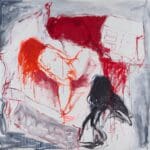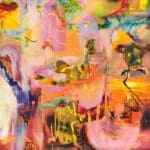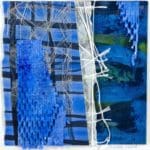Tony Bechara Creates Chaos With Grids
Featured image: Tony Bechara, “ Random 28 (Green version),” detail (2023), acrylic on canvas, 61 x 61 inches (all images © Tony Bechara, courtesy Lisson Gallery)
Tony Bechara is the least-known member of a loosely affiliated group of abstract artists who developed a meticulous approach to the phenomenology of color. Centered in New York around Hunter College, where Sanford Wurmfeld, Gabriele Evertz, Vincent Longo, and Robert Swain taught for many years, this group (active since at least the mid-1970s) has long been interested in color theory and issues of perception, going back to Josef Albers and Georges Seurat. One reason they have flown under the radar can be extrapolated from the art historian William Agee’s observation of Wurmfeld’s Cyclorama projects, an immersive experience in which the viewer is surrounded by color:
“A generation of art, permeated by conceptualism and theory, has devalued the power of the visual; like color itself, as well as art, painting that provides visual pleasure has been seen as too easy, too simple, lacking in “intellectual” depth. This is wrong, for it fails to understand that the mind and eye, the intellect and the senses, cannot be separated, and in fact are inextricably joined in one thinking, feeling body. Sensory intelligence and visual intelligence are fundamental to our being. The visual is profound, for it is how we see and thus how we comprehend the world.”
Although I knew of Bechara from conversations I had with Wurmfeld, I was not prepared for what I encountered in his self-titled debut exhibition at Lisson Gallery. Working in acrylic on square canvases ranging from 24 by 24 inches to 61 by 61 inches, he divides the entire surface into quarter-inch squares in which he paints one of 28 colors.
Read the original article here… and return to share your comments below.























![Artist Shares Secrets of How To Draw Incredibly Realistic Portraits [Interview]](https://artistvenu.studio/wp-content/uploads/2023/12/Screenshot_242-150x150.jpg)







